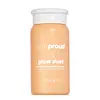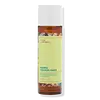What's inside
What's inside
 Key Ingredients
Key Ingredients

 Benefits
Benefits

 Concerns
Concerns

No concerns
 Ingredients Side-by-side
Ingredients Side-by-side

Mannitol
HumectantMicrocrystalline Cellulose
AbsorbentSodium Cocoyl Isethionate
Cleansing3-O-Ethyl Ascorbic Acid
Skin ConditioningButylene Glycol
HumectantCellulose Gum
Emulsion StabilisingLeuconostoc/Radish Root Ferment Filtrate
AntimicrobialPEG-40 Hydrogenated Castor Oil
EmulsifyingCoconut Acid
CleansingBromelain
Skin ConditioningCamellia Sinensis Leaf Extract
AntimicrobialCellulose
AbsorbentWater
Skin ConditioningMoringa Oleifera Seed Extract
Skin ConditioningSodium Isethionate
CleansingGluconolactone
Skin ConditioningSimmondsia Chinensis Seed Oil
EmollientTocopheryl Acetate
AntioxidantMacadamia Integrifolia Seed Oil
Skin ConditioningGlycine Soja Oil
EmollientGlycerin
HumectantFerulic Acid
Antimicrobial1,6-Hexamethylene Diisocyanate
Glycyrrhiza Glabra Root Extract
BleachingPhenoxyethanol
PreservativePotassium Sorbate
PreservativeSodium Benzoate
MaskingDisodium Itaconate
BufferingCitric Acid
BufferingTocopherol
AntioxidantMannitol, Microcrystalline Cellulose, Sodium Cocoyl Isethionate, 3-O-Ethyl Ascorbic Acid, Butylene Glycol, Cellulose Gum, Leuconostoc/Radish Root Ferment Filtrate, PEG-40 Hydrogenated Castor Oil, Coconut Acid, Bromelain, Camellia Sinensis Leaf Extract, Cellulose, Water, Moringa Oleifera Seed Extract, Sodium Isethionate, Gluconolactone, Simmondsia Chinensis Seed Oil, Tocopheryl Acetate, Macadamia Integrifolia Seed Oil, Glycine Soja Oil, Glycerin, Ferulic Acid, 1,6-Hexamethylene Diisocyanate, Glycyrrhiza Glabra Root Extract, Phenoxyethanol, Potassium Sorbate, Sodium Benzoate, Disodium Itaconate, Citric Acid, Tocopherol
Dimethylimidazolidinone Rice Starch
AbsorbentSodium Cocoyl Isethionate
CleansingSodium Lauroyl Glutamate
Sodium Lauroyl Aspartate
CleansingOryza Sativa Powder
Diglycerin
HumectantOryza Sativa Lees Extract
Skin ConditioningCalamine
AbsorbentTapioca Starch
Papain
Skin ConditioningMaltodextrin
AbsorbentAllantoin
Skin Conditioning3-O-Ethyl Ascorbic Acid
Skin ConditioningSimmondsia Chinensis Seed Oil
EmollientWater
Skin ConditioningButylene Glycol
HumectantArnica Montana Flower Extract
MaskingAnanas Sativus Fruit Extract
Skin ConditioningAlchemilla Vulgaris Extract
AstringentActinidia Chinensis Fruit Extract
EmollientDimethylimidazolidinone Rice Starch, Sodium Cocoyl Isethionate, Sodium Lauroyl Glutamate, Sodium Lauroyl Aspartate, Oryza Sativa Powder, Diglycerin, Oryza Sativa Lees Extract, Calamine, Tapioca Starch, Papain, Maltodextrin, Allantoin, 3-O-Ethyl Ascorbic Acid, Simmondsia Chinensis Seed Oil, Water, Butylene Glycol, Arnica Montana Flower Extract, Ananas Sativus Fruit Extract, Alchemilla Vulgaris Extract, Actinidia Chinensis Fruit Extract
 Reviews
Reviews

Alternatives
Ingredients Explained
These ingredients are found in both products.
Ingredients higher up in an ingredient list are typically present in a larger amount.
You might know this ingredient as Ethyl Ascorbic Acid, a more stable version of ascorbic acid.
Like other types of vitamin C, this ingredient has many benefits including reducing wrinkles, skin soothing, dark spot fading, and fighting against free radicals.
3-O-Ethyl Ascorbic Acid interferes with the process of skin darkening, helping to reduce hyperpigmentation. It also encourages the skin to produce more collagen.
Once applied, 3-O-Ethyl Ascorbic Acid is converted to Vitamin C deeper in the skin's layers. This process is slow but makes this ingredient more tolerable for skin.
The optimum pH range for this ingredient is 4 - 5.5
Learn more about 3-O-Ethyl Ascorbic AcidButylene Glycol (or BG) is used within cosmetic products for a few different reasons:
Overall, Butylene Glycol is a safe and well-rounded ingredient that works well with other ingredients.
Though this ingredient works well with most skin types, some people with sensitive skin may experience a reaction such as allergic rashes, closed comedones, or itchiness.
Learn more about Butylene GlycolThis oil comes from the seeds of the desert shrub called Jojoba. It is more commonly known as jojoba oil, a non-comedogenic oil.
Jojoba oil does not contain fragrance and has many fatty-acids, making it a great soothing ingredient.
It also contains Vitamin E, a great moisturizing ingredient. Vitamin E is also an antioxidant and protects your skin against oxidative damage.
This ingredient humectant properties, meaning it helps draw moisture from the air. This helps keep your skin hydrated.
While jojoba has antibacterial properties, it is only able to kill some strains of bacteria.
Studies also show it helps in wound healing. In fact, Indigenous cultures have used jojoba as a moisturizer and to help treat burns for centuries.
Fun fact: Jojoba oil similar to natural human skin sebum, so it has a great effect on dry skin. It is also promising with helping to regulate sebum production.
Due to its fatty acid content, Jojoba oil may not be fungal acne safe. We recommend speaking with a professional if you have any concerns.
Learn more about Simmondsia Chinensis Seed OilSodium cocoyl isethionate is a natural ingredient from coconut oil. It is an ultra gentle cleanser that gives a nice foam without drying the skin or impacting the skin barrier.
The amount of foam created depends on the amount of sodium cocoyl isethionate used in the product.
This ingredient also helps improve the spreadability of a product.
Learn more about Sodium Cocoyl IsethionateWater. It's the most common cosmetic ingredient of all. You'll usually see it at the top of ingredient lists, meaning that it makes up the largest part of the product.
So why is it so popular? Water most often acts as a solvent - this means that it helps dissolve other ingredients into the formulation.
You'll also recognize water as that liquid we all need to stay alive. If you see this, drink a glass of water. Stay hydrated!
Learn more about Water